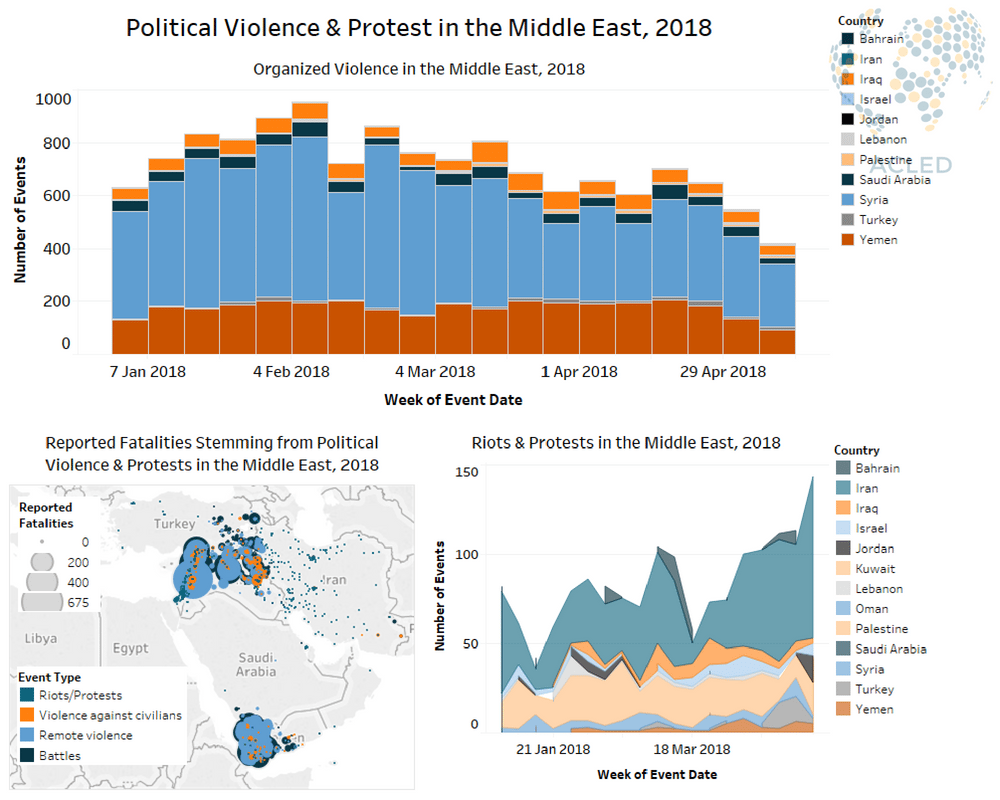Both Lebanon and Iraq held elections last week, with the number of riots and protests as well as election-related violence rising, respectively, in each case. Demonstrations in Iran were focused on “Teacher’s Week” while a smaller subset of demonstrations were focused on the United States’ pulling out of the Iran nuclear deal. Demonstrations were held in Pealstine and Jordan relating to the US embassy move to Jerusalem, with Monday’s widely-publicized events in Gaza falling outside of last week’s coding period (see here for more information on this topic). In Syria, Israeli airstrikes hit a number of Iranian, Hezbollah, and Syrian government targets, while advances by pro-Syrian government forces and Syrian Democratic Forces (QSD), respectively, continued against the Islamic State (IS). Meanwhile, there was a rise in the number of battles reported in Yemen, alongside the capture of strategic positions by anti-Houthi forces.
In Lebanon, the number of riot and protest events rose dramatically last week relating to the country’s parliamentary elections, which were held on May 6. Some clashes were also reported, most notably between supporters of the Future Movement and Hezbollah.
In Iraq, election-related violence escalated ahead of the May 12 parliamentary elections. These events were primarily composed of attacks against candidates in the elections, including the assassination of Faruq Zarzur al-Juburi from the Nation Iraqi Alliance coalition north of Qayyara and a suicide bombing targeting another candidate near Baghdad. Meanwhile, at least one IED attack targeting voters was reported in Hawija district of Kirkuk governorate.
In Iran, a large number of demonstrations focusing on “Teacher’s Week” occurred last week in 32 cities across the country. These were largely peaceful and were focused on low salaries, poor health insurance, and a lack of job security. A smaller subset of protests focused on the US pulling out of the nuclear deal with Iran (i.e. the Joint Comprehensive Plan of Action, or JCPOA), including thousands marching in Tehran and several protests involving the burning of US and Israeli flags.
In Syria, the Israeli Air Force carried out strikes on at least nine Syrian government, Iranian, Hezbollah, and pro-government militia positions and bases in Quneitra, Rural Damascus, and Homs provinces, while also shelling Syrian government and allied positions in Quneitra, resulting in fatalities being reported among members of these forces. To the south of Damascus city, pro-Syrian government forces continued their advances against IS, also capturing several areas in eastern Deir-ez-Zor.
QSD forces and their Coalition allies likewise continued their own offensives against IS in Al-Hasakeh and Deir-ez-Zor, where QSD leadership met with the Iraqi military to plan an upcoming joint operation against IS. Finally, IED attacks and assassinations have escalated in rebel-controlled areas of Idleb, while rebel factions in northern Homs and southern Hama completed the surrender of their heavy weapons as four convoys of fighters and civilians began to evacuate to northern Syrian.
In Yemen, there was a rise in fighting over the past week across the country, with anti-Houthi forces making several important gains in the western areas of the country. In al-Mukha, anti-Houthi forces comprised of government troops, Tihama Resistance forces, Southern Resistance forces, and National Resistance forces managed to take control of the Wazi’iyah and Al-Mukha road junctions from Houthi militants after intense clashes and airstrikes. This paved the way for their taking of Al-Barh town and al-Umari military camp later in the week. This represents a major blow to the Houthi forces, and appears to open a path for the beginning of operations to take the strategic port city of Hudayda from the Houthis.
AnalysisCivilians At RiskConflict MonitoringCurrent HotspotsMiddle EastRemote ViolenceRioting And ProtestsViolence Against Civilians






